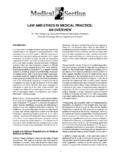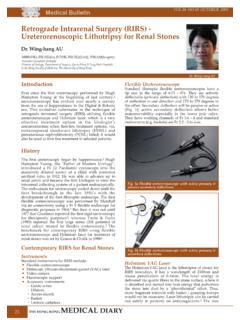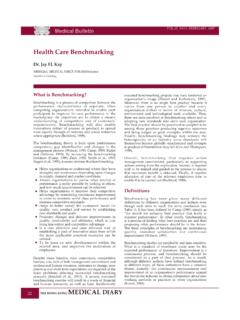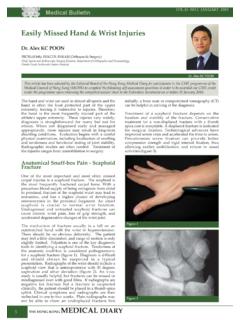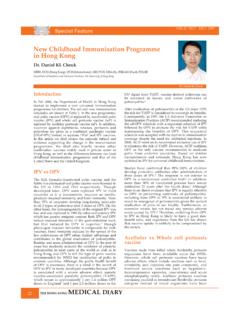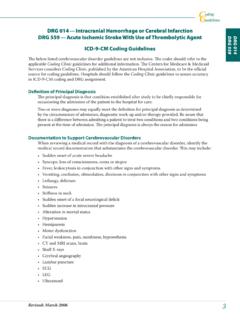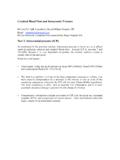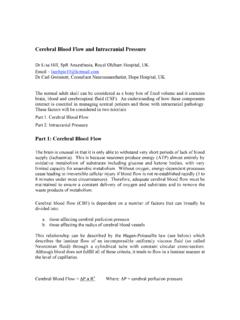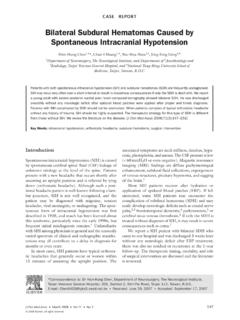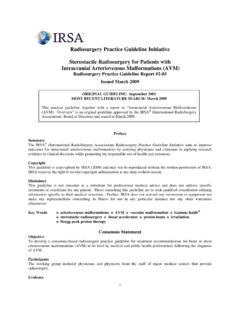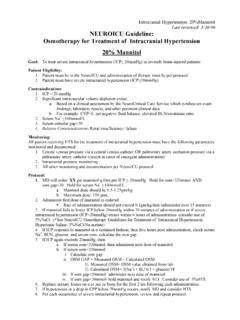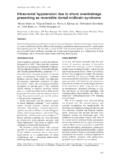Transcription of Management of Unruptured Intracranial Cerebral …
1 Medical FEBRUARY 2011 AAAA6 This article has been selected by the Editorial Board of the Hong Kong Medical Diary for participants in the CME programme of the Medical Council of Hong Kong (MCHK) to complete the following self-assessment questions in order to be awarded one CME credit under the programme upon returning the completed answer sheet to the Federation Secretariat on or before 28 February of Unruptured Intracranial Cerebral AneurysmsDr. Yiu-wah FANDr. Wai-man LUIMBBS (HK), FRCS (SN) (Edin.), FRACS, FCSHK, FHKAM (Surgery)Specialist in NeurosurgeryMBBS, FRCS, FHKAMC onsultant, Division of NeurosurgeryDept of Surgery, The University of Hong KongQueen Mary HospitalDr. Wai-man LUIDr. Yiu-wah FANF indings of incidental Unruptured Intracranial Cerebral aneurysms on MRI or CT brain examinations are getting more common. Epidemiology studies suggest that as many as 5% of people harbour a Cerebral aneurysm by the age Management of such aneurysms is becoming an important subject in our daily medical or Observe?
2 The truly incidental aneurysms are those asymptomatic aneurysms in patients without any history of subarachnoid haemorrhage (SAH). This is a topic of major controversy. Aneurysm represents a weakening in the vessel. It is a degenerative disease with a tendency to enlarge with time. The probability of rupture is related to the size of the aneurysm. Aneurysm rupture is a devastating event. Approximately 15 percent of patients die prior to reaching the hospital and, of those who make it in time, only one-third will have a "good result" after treatment. Therefore, salvage treatment is not is logical to think that one should treat the aneurysms before they rupture. For some time, neurosurgeons are eager to treat incidental aneurysms hoping to prevent subsequent ruptures and try to beat the natural history. The enthusiasm was dampened in 1998 when the International Study of Unruptured Intracranial Aneurysms (ISUIA)7 was published.
3 It was a retrospective study based in North America and Europe and is the biggest study on the subject at the present time. It quoted a rupture rate of per year for aneurysms smaller then 10mm and, per year for aneurysms larger than 10mm. This is much less than what we have formerly believed. Using these figures to compare the treatment risk of about 10% (mortality and morbidity combined), one would find it difficult to recommend prophylactic treatment for any aneurysm less than study was, however, heavily criticised for recruitment and selection bias, and it prompted a prospective study. In the 2003 prospective ISUIA study, the 5-year cumulative rupture rates for patients who did not have a history of subarachnoid haemorrhage with aneurysms located in the internal carotid artery, anterior communicating artery, anterior Cerebral artery, or middle Cerebral artery were 0%, , , and 40% for aneurysms less than 7 mm, 7 12 mm, 13 24 mm, and 25 mm or greater, respectively, compared with rates of , , , and 50%, respectively, for the same size categories involving the posterior circulation and posterior communicating artery This 7mm size is now regarded as the cutoff for treatment by most the ISUIA-II study settled some controversies, what remained puzzled is why we are seeing many small aneurysms, less than 7mm, rupture with SAH and yet the ISUIA study was telling us that they have a very low risk of rupture.
4 From a recent study, of ruptured aneurysms were smaller than 7 mm, and were smaller than 10mm. 3 Among many of us, the belief is that small aneurysms can also rupture and it is better to secure them if technically feasible. When one makes the decision for treating an incidental aneurysm, one does not only take in consideration the size alone. The morphology of the aneurysm is also important. The presence of a daughter sac in the aneurysm, representing a weak point in the aneurysm, will prompt for intervention. Patients with a history of previous SAH, an aneurysm at the posterior circulation, a family history of SAH and patients with autosomal dominant polycystic kidney disease (ADPKD) all pose higher risks of the decision of whether to treat or not is a complex issue and we will consider the following:Factors favouring treatment for incidental > circulation <including PcoA> of daughter sac (representing a weak point in the aneurysm) life expectancy, (young age) of SAH in the history of with ADPKDIn the ISUIA study9, the treatment risk (combined morbidity and mortality) at 1 year was for Medical FEBRUARY 2011 AAAA7clipping and for coiling.
5 Although a simple comparison of treatment risk and natural history can be calculated, one has to take into consideration the psychological factor. No matter what the statistics show, no one can guarantee a risk-free choice. After explaining the pros and cons, we have to take care of the patient s psychology and help them make decision. If the patient cannot accept the psychological burden of having a 'time bomb' in his /her head, treating a small aneurysm may be for AneurysmsIt is generally believed that routine screening for aneurysms in the general population is not indicated. If it is to be carried out, it should be targeted to specific subpopulations at increased risks. Specific genetic syndromes that are associated with an increased risk of SAH include the Ehlers-Danlos syndrome type IV, Marfan syndrome and autosomal dominant polycystic kidney disease (ADPKD). Among them, ADPKD is most indicated for two or more members of the family are affected with aneurysms, screening is recommended for the first-degree relatives.
6 Screening with MRA or CTA is recommended to start in their twenties and then every 5 to 10 years thereafter. Patients with treated aneurysms may develop new aneurysms with Rinne and Hernesniemi suggested in their study of 1150 aneurysm patients, that individuals who present with SAH before the age of 40 may be particularly susceptible to aneurysm formation and may benefit from screening at 5-year we choose not to do surgery, what can we do to help? It has been shown that cigarette smoking, and hypertension are associated with aneurysm formation. Controlling these risk factors theoretically will help the often we should do follow up angiograms?It is common practice to follow up patients with UIA with angiogram. There is really no guideline on this subject. Depending on the size of the lesion, and the intention of the patient, if it is approaching the 7 mm cutoff and the patient is ready to have it treated, then we will do the follow-up angiograms more frequently.
7 A yearly follow up is our usual use MRA for follow-up. MRA can be done without radiation and contrast. Bear in mind that we may need to do many follow up angiograms, especially if the patient is young. Although MRA is not as accurate as DSA for small aneurysms (< 5 mm), it does not really matter if we are using 7 mm as the cutoff for we treat immediately if we see a small growth of aneurysm on follow-up? Or shall we wait until it is bigger than 7 mm?Although we tend to believe most aneurysms grow in a linear fashion, they sometime can enlarge rapidly. From the statistical point of view, there may not be any difference in bleeding risks for a 4 mm aneurysm and a 6 mm aneurysm. We look upon a growing aneurysm as an unstable aneurysm and we tend to treat it when there is documented growth on follow up angiograms, especially if the growth is observation of an Unruptured incidental aneurysm, is it safe to use antiplatelet and anticoagulant?
8 It is understandable that SAH will be more devastating during aneurysm rupture if the patient is on medications that hinder haemostasis. As vascular diseases are prevalent, there is an increasing need for such medications. When confronted with such a problem, we continue to prescribe antiplatelet and anticoagulant if there is a clear indication for them. We tend to believe that these medications do not actually increase the chance of ruptures, but they will make things worse if a rupture occurs. Having said that, the weighting for treating the aneurysm will be higher in such treatment? Clip or coil / stent?Once the decision has been made for treatment, we have a choice of open clipping and endovascular treatment (coiling and stenting). With the rapid development of endovascular technology, and support of the International Subarachnoid Aneurysm Trial (ISAT)5 (which showed less complication with coiling than open clipping in patients with ruptured aneurysms), both patients and doctors are gradually siding towards endovascular treatment.
9 However, one should be careful in assessing the end point of treating Unruptured aneurysms, in which long-term secure control is the aim, especially in young patients. Clipping has a long track record for good secure control whereas endovascular treatment is often associated with recurrences and requirement for the patient is younger than 50 year old and the aneurysm is technically easy to clip, there is a point of going for open clipping. Otherwise, endovascular Management seems to be the treatment of choice especially for posterior-circulation the ISUIA study, the combined morbidity and mortality rates at 1 year were for clipping and for coiling. These are general figures including treatment for large difficult aneurysms, which we know are associated with a high morbidity. With further development in technology, we expect to see lower Medical FEBRUARY 2011 AAAA8management mortality and morbidity in the future.
10 Recent reports, especially with endovascular treatment, have demonstrated a very low risk of treatment ( ).1 Having said that, one very important factor in keeping the treatment risk low is to adopt a conservative attitude during surgery for Unruptured aneurysms. At the time of operation, if there is any difficulty, one should reconsider the need to press on when the risk becomes V, Mitchell P, Molyneux AJ, et al: Endovascular coiling in 131 patients with low complication rate justifies treating most Unruptured Intracranial aneurysms. Cen Eur Neurosurg 71:1-7, 2010 Butler WE, Barker FG Crowell RM. Patients with polycystic kidney disease would benefit from routine magnetic resonance angiographic screening for intracerebral aneurysms: A decision analysis. Neurosurgery 38, 506-516. 1996. Ref Type: GenericJoo SW, Lee SI, Noh SJ, et al: What Is the Significance of a Large Number of Ruptured Aneurysms Smaller than 7 mm in Diameter?


